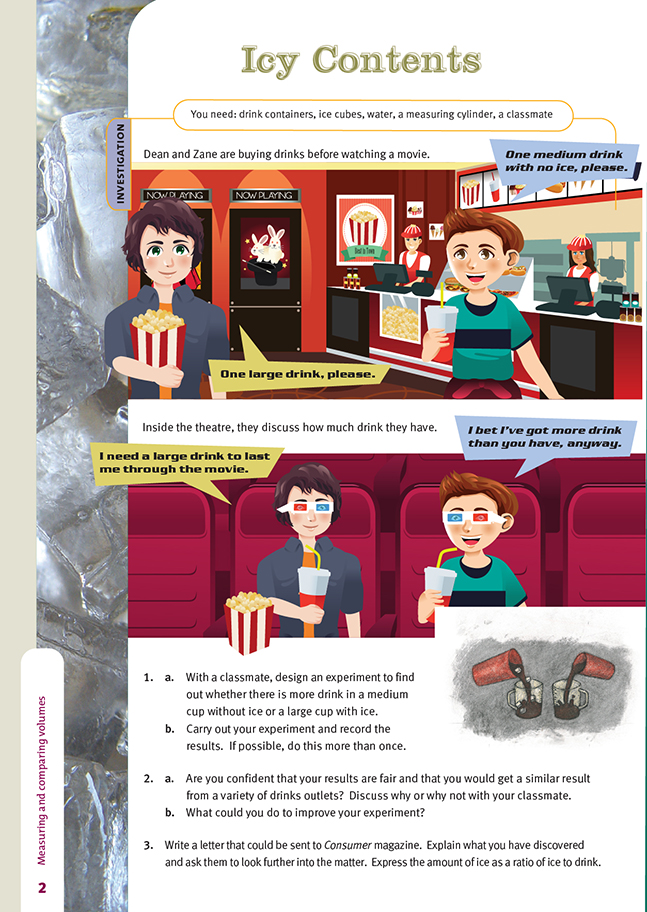This is a level 4 measurement strand activity from the Figure It Out series.
A PDF of the student activity is included.
Click on the image to enlarge it. Click again to close. Download PDF (887 KB)
measure and compare volumes
drink containers, ice cubes, water, a measuring cylinder
classmate
FIO, Level 4, Measurement, Book One, Icy Contents, page 2
Investigation
In this activity, the students investigate a familiar purchase (drinks at fast food restaurants or movie theatres) in order to make a decision about value for money.
Question 1 asks the students to set up what is, in effect, a science experiment as well as a maths investigation. They should be responsible for devising a process that will lead to a valid conclusion and setting it out on paper. There will be a number of different ways of doing this. Once they have sorted out the various steps, they should discuss their method with you so that you have the opportunity to identify possible pitfalls or errors. This planning would be a suitable small-group task.
A trial experiment could be carried out at school or at home. This would clarify the process, identify problems, and may suggest an answer to the original question, but it would not lead to a valid conclusion about what goes on in a real theatre or restaurant. You will need to discuss the concept of validity with your students.
If the activity is to be done in local picture theatres or restaurants, the students will have to work out how to carry it out discreetly and without making a mess. One possible idea would be for them to take two thermos flasks with them in a small bag. They could then transfer the drinks (minus the ice) to the flasks. The actual measuring could then be done at home, and the drink kept cold for later enjoyment!
Question 2 asks the students to evaluate the generality of their findings. They need to realise that there are very big variables (things that change) in their investigation. This means that if they repeated the experiment, they could get quite different results. They should consider how to improve the validity of their conclusions. Hopefully, they will realise that the more times an experiment is repeated and the more places that are sampled, the more general are the conclusions that are reached.
Cross-curricular links
Science
This activity is centred around an hypothesis and investigation that could readily be related to the students’ science programme.
Achievement Objective
- plan and carry out a “fair test” and make decisions about whether the conclusions drawn from an investigation are soundly based (Making Sense of the Nature of Science and its Relationship to Technology, level 4)
English
Question 3 asks for a formal letter that could be sent to Consumer. This could link to work being done in transactional writing.
Achievement Objective
- write instructions, explanations, and factual accounts, and express and explain a point of view, in a range of authentic contexts, organising and linking ideas logically and making language choices appropriate to the audience (Written Language: transactional writing, level 4)
Answers to Activity
1. a.–b.
Results will vary. Generally, ice takes up about one-third of the space in the container. This may be slightly less for small containers.
2. a. Unless you have bought and tested a number of drinks from the same outlet, you will not be able to be sure that other customers will have the same experience, and unless you buy drinks from a number of different outlets, you will not be able to be sure that what is true for one is true for all.
b. Conducting this experiment “in the field” (buying drinks from real outlets) will be better than doing it in the classroom, and the more trials you do the better.
3. Letters will vary.
